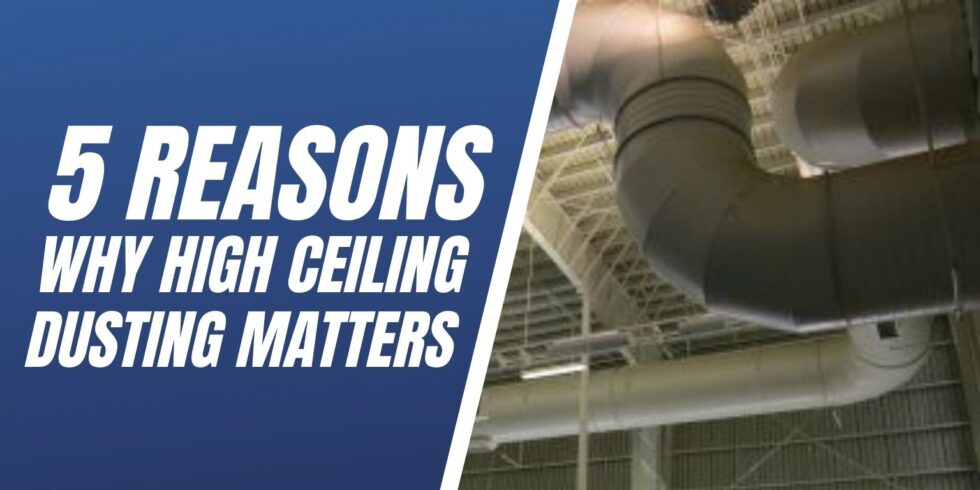
Most industrial facilities produce some sort of dust during the manufacturing process. It’s easy to see dust or dirt at eye level, but when looking up, high surfaces may appear to be clean. But dust, dirt, grease, and other debris are common to find on the ceiling and rafters of many manufacturing and production facilities. While it seems that high surface dust isn’t hurting anything, there are actually many reasons why high ceiling dusting matters.
The ceiling is full of rafters, pipes and ductwork. Dirt and dust travels through the air and lands on these high surfaces, where they accumulate quickly. Since these areas are out of reach and out of sight they don’t get regularly cleaned, which will increase the risks associated with the lack of high ceiling dusting. So, you may be wondering what are the top reasons why high ceiling dusting matters in you facility?
5 Reasons High Ceiling Dusting Matters
1. Debris Falling
Dust on the floor is a sign that there is dust elsewhere in the building, including high up and out-of-sight areas. When the dust from high surfaces, such as rafters and pipes is disturbed from vibrations and/or air movement, it can fall down onto machinery and production equipment. This can cause numerous quality control problems and even damage the machinery.
However, regular high ceiling dusting helps to removes dust, dirt, grease, and other materials commonly found on the high surfaces of manufacturing and production facilities.
2. HVAC System
According to the EPA, a buildup of just 0.42″ of dirt on a heating or cooling coil can result in a decrease of efficiency of 21%. Dirty ductwork can load filters quickly and lead to more stress on the air handler and potentially higher energy costs. Blockages in reheat coils, mixing boxes, VAV boxes and other terminal boxes found in commercial HVAC systems can also restrict airflow. So, if facility’s ducts have not been cleaned and the system is running less efficiently it can lead to poor indoor air quality, which can cause employees to become sick.
Cleaning your facility’s ductwork is the first step in removing airborne contaminants and allergens out of the air they breathe. Duct cleaning is an important part of keeping an environment safe and healthy for everyone that enters through your doors. Since, the ductwork is out of sight, it is often out of mind and may not regularly be cleaned. But a dirty ductwork is the perfect breeding ground for mites, mold, bacteria, viruses, and other poisons that are toxic to the environment.
3. Employee Health Risks
Not only do dirty ductwork cause the HVAC system to run less efficiently, but they are the perfect breeding ground for mites, mold, bacteria, viruses, and other poisons that could contribute to Sick Building Syndrome. Mites and mold can cause allergic reactions in some people; bacteria and viruses will spread throughout the building making your employees sick.
Dust can also be a slipping hazard when it collects on walking surfaces; the small particles reduce the traction that people are used to when walking in a building. Slips are one of the main causes of workplace injury, and within those injuries dust is one of the main causes of those slips.
4. Combustible Dust Explosion
As an industrial facility, you produce a lot of dust, and over time that dust collects on machinery, floors, and on high surfaces. Unfortunately, many facilities only think about cleaning areas that are visible and certain types of dusts can pose a fire hazard when they collect in large enough areas. Many secondary explosions in factories have been caused by an explosive dust cloud forming when dust is knocked down from these high surfaces.
Many types of dust become explosive under the right conditions, and there have been numerous cases of uncleaned dust coming into contact with an ignition source and exploding. The dust explosion pentagon has been created to explain how these explosions form and how to prevent them, and OSHA and the NFPA have been developing new codes to help combat this issue.
5. OSHA Fines
OSHA has been paying attention to the dangers that dust in the workplace can create and has been cracking down on companies that aren’t following housekeeping rules. The Combustible Dust National Emphasis Program was created by OSHA to deal with this issue, and has already cited almost five thousand businesses for dust accumulations, with fines ranging from thousands of dollars to hundreds of thousands.
Think your facility could benefit from high ceiling dusting this winter. Contact Us Here or call us at 888-845-3952 to find out how Hughes Environmental can help get rid of the dust in your business.

